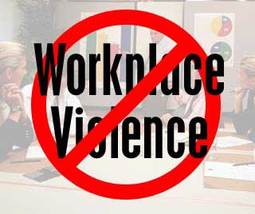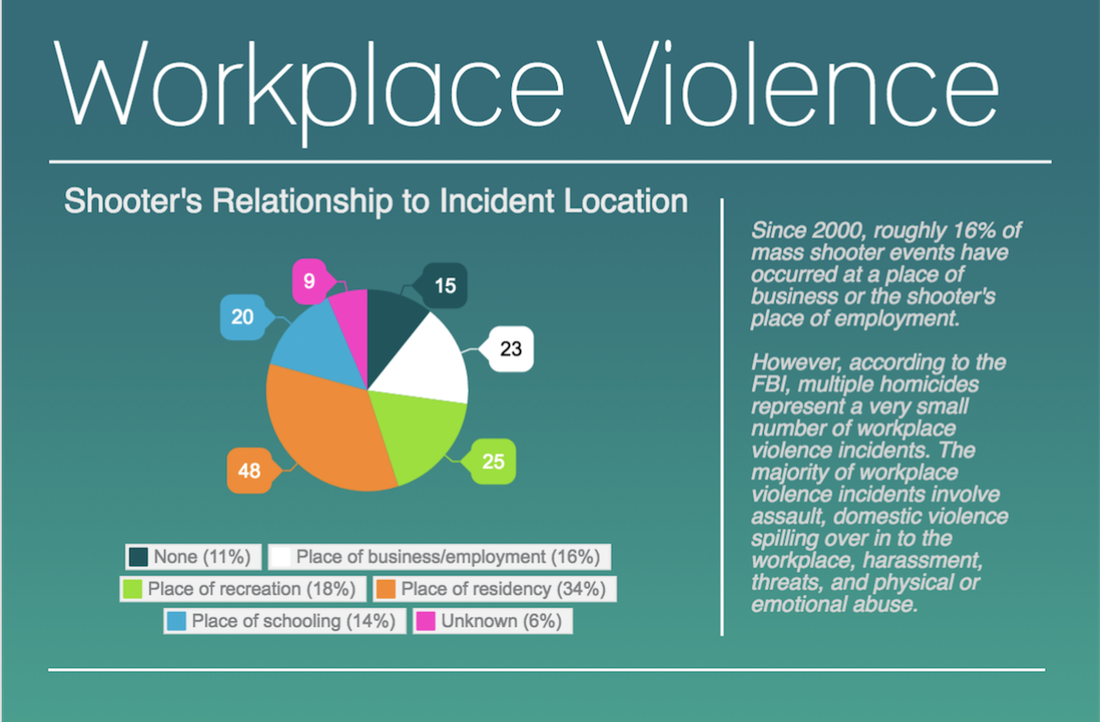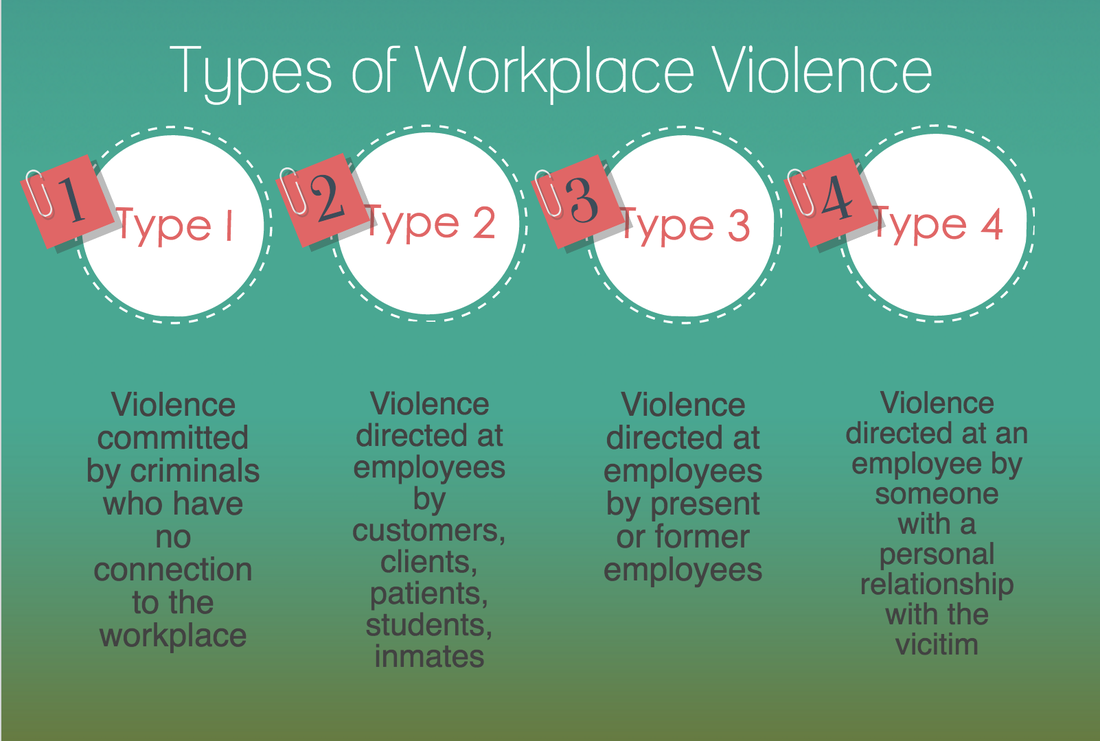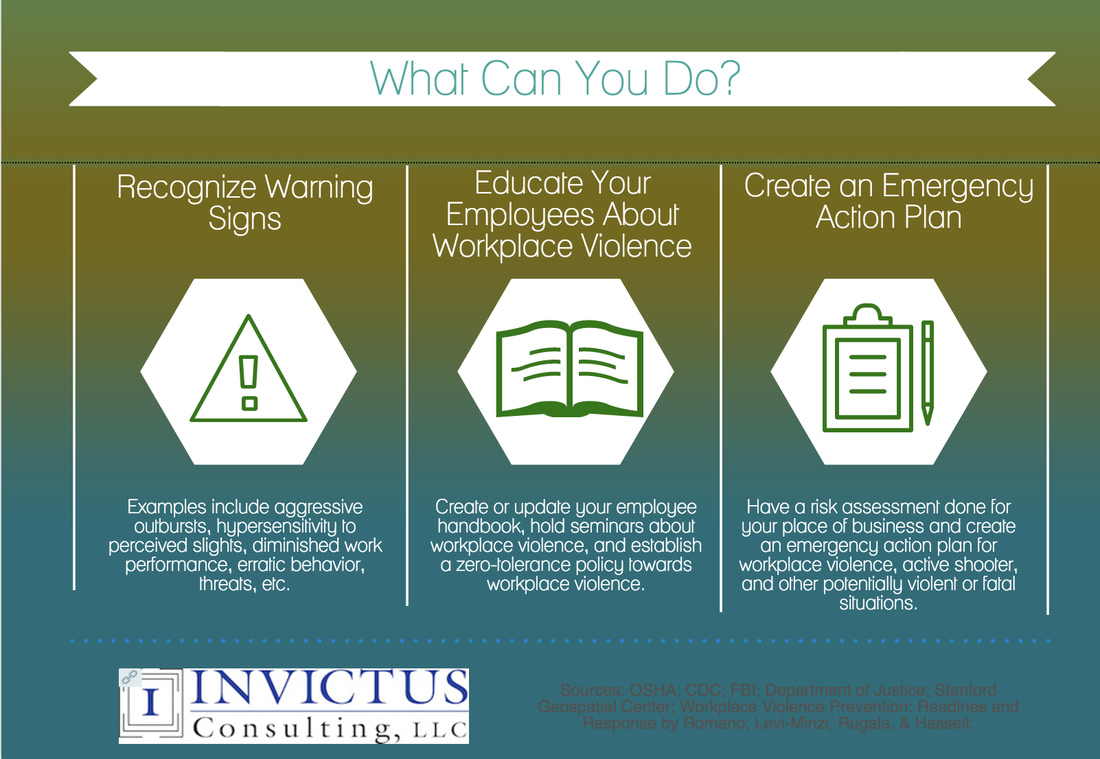|
by Joy Dike, PhD We talk about workplace violence frequently here at Invictus Consulting, but we feel pretty strongly about the topic and will continue to talk about it until its no longer a problem. We've written a white paper on the topic if you'd like to check it out.
0 Comments
by Joy Dike, PhD  We talk a lot about active shooters, mass shootings, and workplace violence here on the Invictus Consulting blog. Here we go again... Recently a man walked into a leasing office at an apartment complex In Tallahassee and opened fire. What we know so far is that this man was acting out in retaliation for his wife having been fired from her job at the apartment complex earlier that day. He shot an employee of the apartment complex 6 times (not fatally) and then went back outside and casually waited for the police to come, looking, "like a man who had accomplished his goal." Let's look at this case in the context of active shooter, mass shootings, and workplace violence. Is this man an active shooter? Is this an an instance of a mass shooting? Is this a case of workplace violence? Remember that the agreed-upon definition (by the White House, the Department of Homeland Security, the Department of Justice, the Department of Education, and the Federal Emergency Management Agency) of an active shooter is "an individual actively engaged in killing or attempting to kill people in a confined and populated area; in most cases, active shooters use firearm(s) and there is no pattern or method to their selection." Is he an active shooter? Was he:
Was it a mass shooting? While there is little consensus on what defines a mass shooting (see this blog post and this white paper on active shooter statistics for a more detailed explanation of this topic), all definitions assume at least 3 people are shot. This instance, then, would not be classified as a mass shooting. Is this a case of workplace violence? There are four types of workplace violence offenders:
Now that we've determined that this is not a mass shooting, is potentially not an active shooter situation, but is definitely a case of workplace violence, do you feel relieved? Safer? More scared? Glad that one less active shooter case has NOT happened in the United States? The reality is that workplace violence - whether it is a case of domestic violence, harassment, emotional abuse, threats, or an actual armed gunman - poses a greater threat to the daily safety of workers than do active shooters. Workplace violence occurs every day in places all over the country, and someone does not need to be wielding a gun to be classified as engaging in workplace violence; most instances of workplace violence do not involve guns at all. We've said it before, and we will say it again until workplaces are truly safe, but you need to have a workplace violence policy (i.e., a zero-tolerance policy), you need to make sure employees know about and follow the policy, and you need to make sure that your employees feel safe at work. by Joy Dike, PhD  A zero-tolerance policy towards workplace violence starts with having employees report violent or threatening behavior. Without this first step, no policy will be truly effective against workplace violence. How can you create an environment where employees will feel comfortable reporting threats? 1. Encourage employees to report violent or threatening behavior This means creating an environment where employees feel comfortable reporting issues to their supervisors or up the management chain and don't feel alienated from management. 2. Make sure employees know where and how to report violent or threatening behavior This means having a clear and specific method for employees to report issues. It may mean reporting through:
Within any or all of these channels, there needs to be a clear and defined method of reporting. That may mean something as simple as a conversation or a form filled out. Whatever the method, document it. 3. Publicize the policy A solid policy and method of reporting issues isn't effective if employees don't know about it. Publicizing your workplace violence policy could be as simple as:
4. Make sure your employees know that you will take their report seriously Your employees need to know that their concerns will be heard and that someone will follow up on the issue. A procedure whereby employees will be notified about how their report was addressed will go a long way towards building confidence in the system. The first step in creating a zero-tolerance policy towards workplace violence is creating an atmosphere in which your employees feel comfortable reporting issues and feel like their voices will be heard. Click here to download our white paper about workplace violence. by Joy Dike, PhD  We come across a vast array of office cultures. The ones that give rise to the most problems are those that lack an environment of communication, but at the same time cultivate an environment of fear of rejection or reprisals for speaking up. If you find that that is your institution, then the following is for you: The Occupational Safety & Health Administration (OSHA) has one overarching suggestion for reducing workplace violence hazards: "One of the best protections employers can offer their workers is to establish a zero-tolerance policy toward workplace violence. This policy should cover all workers, patients, clients, visitors, contractors, and anyone else who may come in contact with company personnel." There are many aspects that go in to a zero-tolerance policy, but it all starts with making sure employees report and log violent and threatening behaviors by coworkers. How can you kill your zero-tolerance policy before it even gets off the ground? 1. Make sure your employees feel scared of their supervisors. Double down and make sure they're also too afraid to report violent or threatening behavior up the normal management channels. 2. Make sure your employees are alienated from management. You don't want employees feeling comfortable enough with management to bring their concerns forward. 3. Make sure your employees have no idea how to report violent or threatening behavior. Better yet, don't even set a policy for reporting violent or threatening behavior. If there's no policy, you won't get any reports and your job is done! 4. Make sure your employees are clear that no action will be taken if they report violent or threatening behavior. Try a paper shredder at the bottom of the suggestion box. That way reports won't even be seen let alone investigated. In all seriousness, employees need to have a clear picture about how and when to report violent or threatening behavior. No workplace violence policy will be effective if people don't know how to report threats. Come back in the next few days to learn some steps towards implementing a solid and effective zero-tolerance workplace violence policy. by Joy Dike, PhD  "I'm so mad I could kill someone." Have you ever heard someome say something like this at work? Listen, workplace violence is a serious issue, and threatening behavior in the workplace is not something to take lightly. The FBI indicates that there is no profile or litmus test that exists to demonstrate whether an employee might become violent. There are, however, some problem situations that may give rise to violence – personality conflicts between coworkers; mishandled termination or disciplinary action; weapons at the worksite; or drug or alcohol abuse at the worksite. Other risk factors are personal but spill over into the workplace – the breakup of a marriage or romantic relationship; family conflict; financial or legal problems; or emotional problems. It is well documented that individuals rarely snap and engage in workplace violence without first exhibiting behaviors of concern. Knowing and reporting these behaviors of concern is just as important as understanding the problem situations and risk factors that often precede behaviors of concern. Such behaviors of concern could include depression, threats, menacing behavior, erratic behavior, aggressive outburst, offensive conversation, jokes referring to violence, increasing tardiness, increasing absenteeism, worsening relationships with coworkers, decreased productivity, homicidal comments, increasing belligerence, hypersensitivity to criticism, and verbal abuse. Of course any of these behaviors alone is not necessarily more suggestive of potential workplace violence, but many of these behaviors taken together should raise warning flags. Let's revisit the person who yelled, "I'm so mad I could kill someone!" Is this a threat that should be taken seriously? The answer really lies in the collective past behavior of the individual making the threat. Let's say this particular person has been increasingly tardy to work, has showed a marked decrease in productivity, and has regularly shown up to work disheveled. In this case, yes, this threat should be taken seriously. Having a risk management plan that incorporates workplace violence is an important part of keeping your employees, clients, and place of business safe. Make sure people understand what behavior your expect from them and how to detect erratic and threatening behavior. by Joy Dike, PhD  We're based in the southeast, and we sure do love our guns here in the south. Both literal and metaphorical, that is. In fact, all fifty states have passed some sort of legislation that allows individuals to to carry concealed firearms in public. Of course the requirements to obtain a permit, the types of firearms allowed, and the types of locations deemed "public" vary from state to state, but the fact is that individuals have some level of right to carry a firearm in all fifty states. With that in mind, it behooves every business to have a written firearms policy, both for their employees and their customers/clients (if customers physically come in to your place of business). We aren't going to tell you how to write a firearms policy in this blog post, but we will leave you with some thought provoking questions as you think about this issue for your place of business: How do you determine your firearms policy? Who is the individual responsible for determining that policy? What are the legal ramifications for setting such a policy? Above all, who is the enforcer of this policy? by Joy Dike, PhD  Workplace violence is an unfortunate reality in today’s world. Domestic violence spilling over to the workplace, sexual harassment, physical violence, intimidation, threats, and disruptive behavior all occur at the workplace. It is well documented that workplace homicides are in decline, but other forms of workplace violence such as harassment, physical fighting, and verbal abuse are on the rise. In addition, active shooter incidents and mass shootings are on the rise. Employers have a legal and ethical obligation to provide a workplace free of threats and violence. So what can you do to address the issue of workplace violence at your place of business? Here are a few ideas to get you started:
There must be support from the top of a business or organization if there is going to be any meaningful action taken to address workplace violence. It is important to understand that here is no one-size-fits-all strategy to this issue. Each business, each organization, each campus or location will have different risks associated with it and thus require a unique plan. Read Here for a more in-depth look at workplace violence. by Joy Dike, PhD  Workplace violence is an unfortunate but important topic that all employers and employees need to consider. The issue of violence in the workplace has been addressed by OSHA, the CDC’s NIOSH (National Institute for Occupational Safety and Health), the FBI, the DOJ, and the National Center of Victims of Crime. According to OSHA, workplace violence is any act or threat of physical violence, harassment, intimidation, or other threatening or disruptive behavior that occurs at the work site. The news media sensationalizes workplace violence episodes like the Fort Hood shooting, the shooting of a Virginia news crew during a live broadcast, the shooting at Chattanooga military facilities, or the Washington Navy Yard shooting. These are tragic and alarming episodes, yes. The truth is, however, that the majority of workplace violence employers and managers have to deal with on a daily basis runs more along the lines of domestic violence, harassment, emotional abuse, and threats - not armed gunmen. Workplace violence causes ripple effects in terms of costs to the American economy. The Department of Justice estimates that workplace violence costs the American workforce over $30 billion annually; the FBI further explains this loss to include lost work time, lost wages, reduced productivity, medical costs, workers’ compensation payments, legal expenses, and security expenses. Beyond these tangible costs, workplace violence also creates anxiety, fear, and a climate of distrust in the workplace. It is well documented that individuals rarely snap and engage in workplace violence without first exhibiting behaviors of concern. Knowing and reporting these behaviors of concern is just as important as understanding the problem situations and risk factors that often precede behaviors of concern. Such behaviors of concern could include depression, threats, menacing behavior, erratic behavior, aggressive outburst, offensive conversation, jokes referring to violence, increasing tardiness, increasing absenteeism, worsening relationships with coworkers, decreased productivity, homicidal comments, increasing belligerence, hypersensitivity to criticism, and verbal abuse. Of course any of these behaviors alone is not necessarily more suggestive of potential workplace violence, but many of these behaviors taken together should raise warning flags. Continue to follow this blog as we look at how an Emergency Action Plan can help you address workplace violence. |
Archives
June 2016
Categories
All
|





 RSS Feed
RSS Feed
